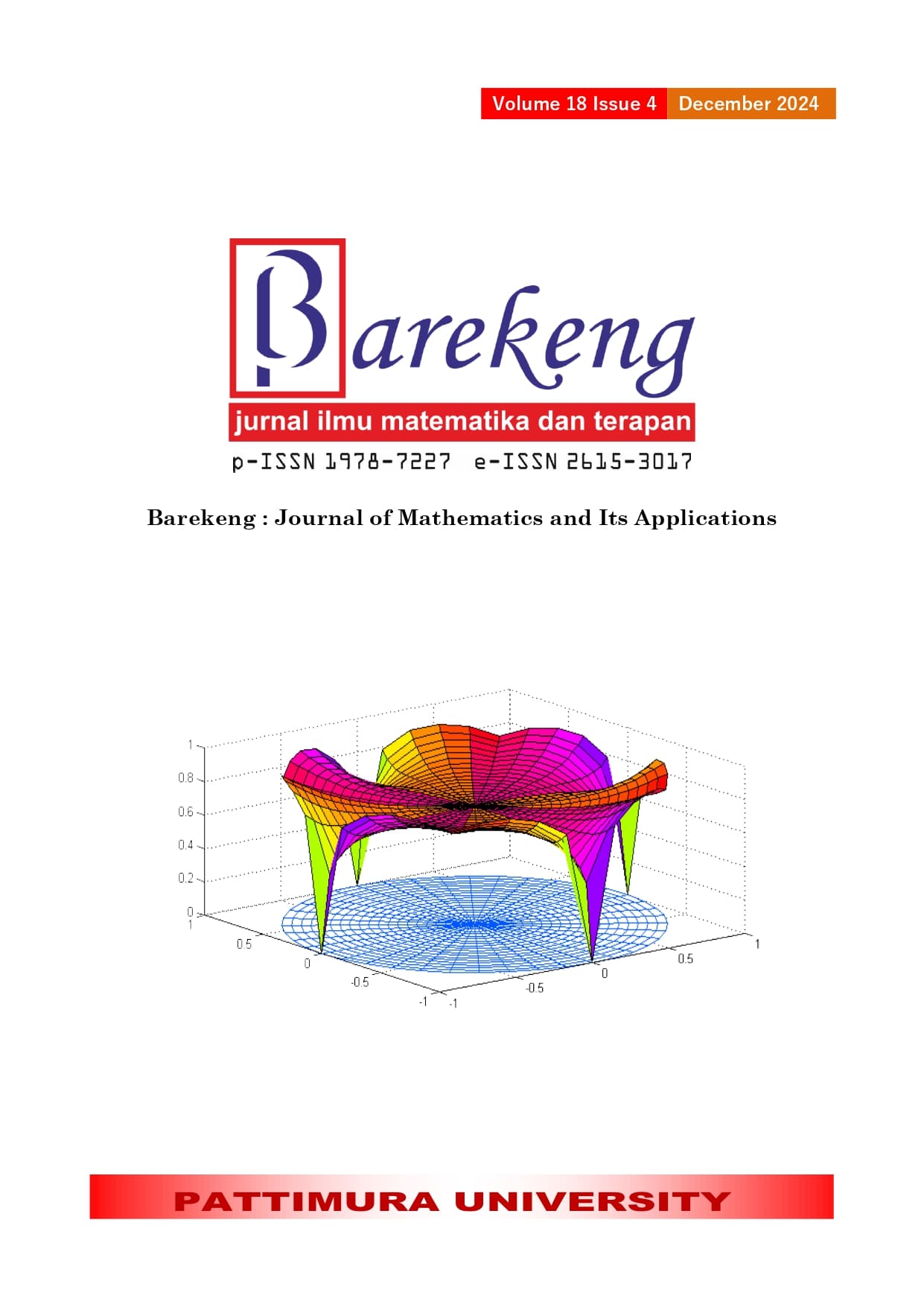PREDICTION SYSTEM FOR THE AMOUNT OF SUGAR PRODUCTION USING ADAPTIVE NEURO-FUZZY INFERENCE SYSTEM
Abstract
Sugar is one of the staple foods most Indonesians use, so sugar production needs to be done optimally to meet people's needs. This research will design a prediction system for the amount of sugar production in PTPN XI PG Prajekan using the Adaptive Neuro-Fuzzy Inference System (ANFIS) method. ANFIS is a combined method of two systems, namely a fuzzy logic system and an artificial neural network system. This research consists of data collection, ANFIS system design, ANFIS training, ANFIS testing, accuracy calculation, and result analysis. The prediction system for the amount of sugar production is designed to predict the variable which is the amount of sugar production in the year using the input variables (sugarcane harvested area in year ), (amount of sugarcane in year ), (average of yield in year ), and (number of milling days in year ). The experiments in this research used variations of the type of membership function and the number of membership functions. The best model obtained in this research is a model with a difference between two sigmoidal membership functions and a product of two sigmoidal membership functions with a total of 2 membership functions for each input variable. Both models have the same Mean Absolute Percentage Error (MAPE) value, which is 1.79% in the training process and 4.82% in the testing process.
Downloads
References
B. P. Statistik, Statistik Tebu Indonesia 2019, vol. 13, no. 1. Jakarta: BPS RI, 2019.
C. N. Aliza, “Faktor-Faktor Yang Mempengaruhi Produksi Gula Di Indonesia,” Universitas Muhammadiyah Surakarta, 2019.
A. Syafri and I. S. Sudrajat, “Faktor-Faktor Yang Mempengaruhi Produksi Gula Di PT. Madubaru (Madukismo) Yogyakarta,” J. Ilm. Agritas, vol. 2, no. 2, pp. 13–26, 2018.
A. Setiawan, B. Yanto, and K. Yasdomi, Logika Fuzzy Dengan Matlab. Bali: Jayapangus Press, 2018.
D. R. Rochmawati, “Prediksi Cuaca dengan Jaringan Syaraf Tiruan menggunakan Python,” vol. 2, no. 2, 2024.
F. M. Siregar, G. W. Nurcahyo, and S. Defit, “Prediksi Hasil Ujian Kompetensi Mahasiswa Program Profesi Dokter (UKMPPD) dengan Pendekatan ANFIS,” J. RESTI (Rekayasa Sist. dan Teknol. Informasi), vol. 2, no. 2, pp. 554–559, 2018, doi: 10.29207/resti.v2i2.388.
S. A. Harahap and S. N. Endah, “Penerapan Adaptive Neuro-Fuzzy Inference System untuk Prediksi Nilai Tukar Rupiah,” J. Masy. Inform., vol. 10, no. 1, pp. 37–47, 2019, doi: 10.14710/jmasif.10.1.31488.
Y. Tri Nugraha, M. F. Zambak, and A. Hasibuan, “Perkiraan Konsumsi Energi Listrik Di Aceh Pada Tahun 2028 Menggunakan Metode Adaptive Neuro Fuzzy Inference System,” CESS (Journal Comput. Eng. Syst. Sci., vol. 5, no. 1, p. 104, 2020, doi: 10.24114/cess.v5i1.15624.
Mutmainah, “Prediksi Indeks Harga Konsumen di Kota Denpasar-Bali Menggunakan Metode Adaptive Neuro-Fuzzy Inference System (ANFIS),” UIN Syarif Hidayatullah Jakarta, 2021. [Online]. Available: https://repository.uinjkt.ac.id/dspace/handle/123456789/56947%0Ahttps://repository.uinjkt.ac.id/dspace/bitstream/123456789/56947/1/MUTMAINAH-FST.pdf
A. Matsniya, “Penerapan Metode Adaptive Neuro Fuzzy Inference System dalam Prediksi Produksi Tembakau di Kabupaten Jember,” Universitas Jember, 2022.
A. D. Mulyanto, “mVIF Package: A Tool for Detecting Multicollinearity without Dependent Variables,” MATICS J. Ilmu Komput. dan Teknol. Inf. (Journal Comput. Sci. Inf. Technol., vol. 14, no. 2, pp. 70–73, 2022, doi: 10.18860/mat.v14i2.20948.
A. J. Rindengan and Y. A. R. Langi, Sistem Fuzzy. Bandung: CV. Patra Media Grafindo, 2019.
Tarno, A. Rusgiyono, and Sugito, “Adaptive Neuro Fuzzy Inference System (ANFIS) approach for modeling paddy production data in Central Java,” J. Phys. Conf. Ser., vol. 1217, no. 1, pp. 1–8, 2019, doi: 10.1088/1742-6596/1217/1/012083.
B. Santoso, A. I. . Azis, and Zohrahayaty, Machine Learning & Reasoning Fuzzy Logic Algoritm, Manual, & Rapid Miner. Yogyakarta: Deepublish, 2020.
S. A. F. Pramesti, U. A. S. Sadikin, I. Nurfitri, and F. Maulida, “Prediksi Indeks Harga Konsumen Kota Pontianak Menggunakan Metode Double Exponential Smoothing dan Analysis Trend,” Equator J. Math. Stat. Sci., vol. 2, no. 2, pp. 37–47, 2023, [Online]. Available: https://jurnal.untan.ac.id/index.php/EMSS/article/view/73302
Copyright (c) 2024 Ahmad Kamsyakawuni, Walidatush Sholihah, Abduh Riski

This work is licensed under a Creative Commons Attribution-ShareAlike 4.0 International License.
Authors who publish with this Journal agree to the following terms:
- Author retain copyright and grant the journal right of first publication with the work simultaneously licensed under a creative commons attribution license that allow others to share the work within an acknowledgement of the work’s authorship and initial publication of this journal.
- Authors are able to enter into separate, additional contractual arrangement for the non-exclusive distribution of the journal’s published version of the work (e.g. acknowledgement of its initial publication in this journal).
- Authors are permitted and encouraged to post their work online (e.g. in institutional repositories or on their websites) prior to and during the submission process, as it can lead to productive exchanges, as well as earlier and greater citation of published works.






1.gif)



